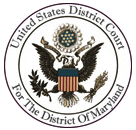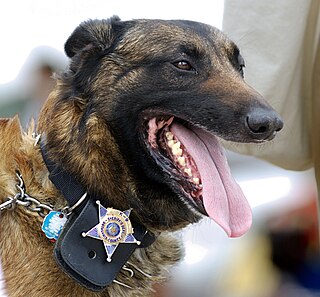
The Fourth Amendment to the United States Constitution is part of the Bill of Rights. It prohibits unreasonable searches and seizures and sets requirements for issuing warrants: warrants must be issued by a judge or magistrate, justified by probable cause, supported by oath or affirmation, and must particularly describe the place to be searched and the persons or things to be seized.

Search and seizure is a procedure used in many civil law and common law legal systems by which police or other authorities and their agents, who, suspecting that a crime has been committed, commence a search of a person's property and confiscate any relevant evidence found in connection to the crime.
United States v. Place, 462 U.S. 696 (1983), is a decision by the Supreme Court of the United States in which the Court held that it does not violate the Fourth Amendment to the U.S. Constitution for a trained police dog to sniff of a person's luggage or property in a public place.
Katz v. United States, 389 U.S. 347 (1967), was a landmark decision of the U.S. Supreme Court in which the Court redefined what constitutes a "search" or "seizure" with regard to the Fourth Amendment to the U.S. Constitution. The ruling expanded the Fourth Amendment's protections from an individual's "persons, houses, papers, and effects," as specified in the Constitution's text, to include any areas where a person has a "reasonable expectation of privacy." The reasonable expectation of privacy standard, now known as the Katz test, was formulated in a concurring opinion by Justice John Marshall Harlan II.
Kyllo v. United States, 533 U.S. 27 (2001), was a decision by the Supreme Court of the United States in which the court ruled that the use of thermal imaging devices to monitor heat radiation in or around a person's home, even if conducted from a public vantage point, is unconstitutional without a search warrant. In its majority opinion, the court held that thermal imaging constitutes a "search" under the Fourth Amendment, as the police were using devices to "explore details of the home that would previously have been unknowable without physical intrusion." The ruling has been noted for refining the reasonable expectation of privacy doctrine in light of new surveillance technologies, and when those are used in areas that are accessible to the public.
Section 8 of the Canadian Charter of Rights and Freedoms protects against unreasonable search and seizure. This right provides those in Canada with their primary source of constitutionally enforced privacy rights against unreasonable intrusion from the state. Typically, this protects personal information that can be obtained through searching someone in pat-down, entering someone's property or surveillance.
Illinois v. Caballes, 543 U.S. 405 (2005), is a decision by the Supreme Court of the United States in which the Court held that the use of a drug-sniffing police dog during a routine traffic stop does not violate the Fourth Amendment to the U.S. Constitution, even if the initial infraction is unrelated to drug offenses.
South Dakota v. Opperman, 428 U.S. 364 (1976), elaborated on the community caretaking doctrine. Under the Fourth Amendment, "unreasonable" searches and seizures are forbidden. In addition to their law-enforcement duties, the police must engage in what the court has termed a community caretaking role, including such duties as removing obstructions from roadways to ensure the free flow of traffic. When the police act in this role, they may inventory cars they have seized without "unreasonably" searching those cars.
Smith v. Maryland, 442 U.S. 735 (1979), was a Supreme Court case holding that the installation and use of a pen register by the police to obtain information on a suspect's telephone calls was not a "search" within the meaning of the Fourth Amendment to the United States Constitution, and hence no search warrant was required. In the majority opinion, Justice Harry Blackmun rejected the idea that the installation and use of a pen register constitutes a violation of the suspect's reasonable expectation of privacy since the telephone numbers would be available to and recorded by the phone company anyway.
Ferguson v. City of Charleston, 532 U.S. 67 (2001), is a United States Supreme Court decision that found Medical University of South Carolina's policy regarding involuntary drug testing of pregnant women to violate the Fourth Amendment. The Court held that the search in question was unreasonable.
Bond v United States, 529 U.S. 334 (2000), was a United States Supreme Court Fourth Amendment case that applied the ruling of Minnesota v. Dickerson to luggage, which held that police may not physically manipulate items without a warrant without violating the Fourth Amendment. The Court ruled that this satisfied the two prong test established by Katz v. United States that, (1) a subjective expectation of privacy in the area in question and (2) that the expectation is reasonable in order for the protections of the Fourth Amendment. In this case, the Court ruled that since the Defendant tried to preserve his privacy by using an opaque bag and that it is reasonable for the Defendant to believe that his bag would not be felt in an "exploratory manner" that the two prongs were satisfied.
Ontario v. Quon, 560 U.S. 746 (2010), is a United States Supreme Court case concerning the extent to which the right to privacy applies to electronic communications in a government workplace. It was an appeal by the city of Ontario, California, from a Ninth Circuit decision holding that it had violated the Fourth Amendment rights of two of its police officers when it disciplined them following an audit of pager text messages that discovered many of those messages were personal in nature, some sexually explicit. The Court unanimously held that the audit was work-related and thus did not violate the Fourth Amendment's protections against unreasonable search and seizure.
O'Connor v. Ortega, 480 U.S. 709 (1987), is a United States Supreme Court decision on the Fourth Amendment rights of government employees with regard to administrative searches in the workplace, during investigations by supervisors for violations of employee policy rather than by law enforcement for criminal offenses. It was brought by Magno Ortega, a doctor at a California state hospital after his supervisors found allegedly inculpatory evidence in his office while he was on administrative leave pending an investigation of alleged misconduct. Some of what they uncovered was later used to impeach a witness who testified on his behalf at the hearing where he unsuccessfully appealed his dismissal.
Mancusi v. DeForte, 392 U.S. 364 (1968), is a decision of the United States Supreme Court on privacy and the Fourth Amendment. It originated in the lower courts as United States ex rel. Frank DeForte, appellant v. Vincent R. Mancusi, Warden of Attica Prison, Attica, New York, appellee, a petition for a writ of habeas corpus by a prisoner who had exhausted all his state appeals. By a 6–3 margin the Court affirmed the United States Court of Appeals for the Second Circuit's reversal of a district court denial of the petition.
United States v. Jones, 565 U.S. 400 (2012), was a landmark United States Supreme Court case in which the court held that installing a Global Positioning System (GPS) tracking device on a vehicle and using the device to monitor the vehicle's movements constitutes a search under the Fourth Amendment.

United States v. Graham, 846 F. Supp. 2d 384, was a Maryland District Court case in which the Court held that historical cell site location data is not protected by the Fourth Amendment. Reacting to the precedent established by the recent Supreme Court case United States v. Jones in conjunction with the application of the third party doctrine, Judge Richard D. Bennett found that "information voluntarily disclosed to a third party ceases to enjoy Fourth Amendment protection" because that information no longer belongs to the consumer, but rather to the telecommunications company that handles the transmissions records. The historical cell site location data is then not subject to the privacy protections afforded by the Fourth Amendment standard of probable cause, but rather to the Stored Communications Act, which governs the voluntary or compelled disclosure of stored electronic communications records.

Florida v. Jardines, 569 U.S. 1 (2013), was a United States Supreme Court case which resulted in the decision that police use of a trained detection dog to sniff for narcotics on the front porch of a private home is a "search" within the meaning of the Fourth Amendment to the United States Constitution, and therefore, without consent, requires both probable cause and a search warrant.
The third-party doctrine is a United States legal doctrine that holds that people who voluntarily give information to third parties—such as banks, phone companies, internet service providers (ISPs), and e-mail servers—have "no reasonable expectation of privacy" in that information. A lack of privacy protection allows the United States government to obtain information from third parties without a legal warrant and without otherwise complying with the Fourth Amendment prohibition against search and seizure without probable cause and a judicial search warrant.
Carpenter v. United States, 585 U.S. 296 (2018), is a landmark United States Supreme Court case concerning the privacy of historical cell site location information (CSLI). The Court held that government entities violate the Fourth Amendment to the United States Constitution when accessing historical CSLI records containing the physical locations of cellphones without a search warrant.
Digital Search and Seizure refers to the ability of the United States Government to obtain and read an individual's private digital correspondence and material under The Fourth Amendment of the United States Constitution.



